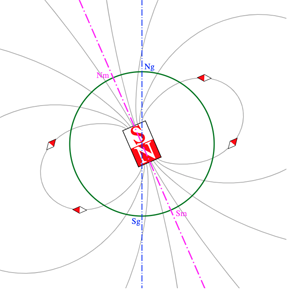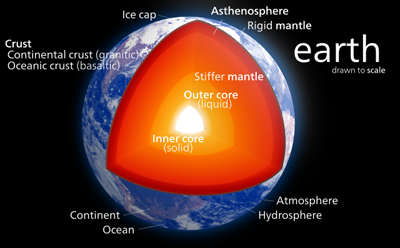Plus Advent Calendar Door #6: Why is the Earth a magnet?
Good question. The Earth is indeed a magnet, although it's very weak. A good fridge magnet is over 200 times stronger. As a very crude approximation, you can imagine the Earth's magnetic field to be that of a bar magnet at the centre of the Earth, which is roughly aligned with the axis the Earth spins around, but tilted by about 11 degrees. The points where the North-South axis of this magnet intersects the Earth's surface are called the geomagnetic poles. Because of the tilt of the magnet's axis, the geomagnetic poles are not in the same places as the geographic poles.

This diagram illustrates how the Earth's magnetic field can be approximated by that of a bar magnet. The blue axis represents the Earth's rotational axis with the geographic North and South poles at top and bottom. The pink line represents the orientation of the bar magnet with North and South geomagnetic poles. Figure: JrPole, CC BY-SA 3.0.
Scientists think that the Earth's magnetic field is generated by electrical currents running through the liquid, molten iron that forms the outer layer of the Earth's core. In effect, the Earth behaves like a massive dynamo, not unlike the dynamos that power bicycle lights (you can find out more in this article). But because the liquid in the Earth's outer core is continually sloshing about, the Earth's magnetic field displays tangles a simple bar magnet can't rival, and it also changes over time — it can even flip, reversing its North and South magnetic poles. The details of what's going on, and the theory explaining the dynamo process, are far from understood.

The internal structure of the Earth. Figure: Kelvinsong, CC BY-SA 3.0.
Find out more about dynamo theory and how it explains the Earth's magnetic field in this longer article.
Return to the Plus advent calendar 2022.
This article was produced as part of our collaboration with the Isaac Newton Institute for Mathematical Sciences (INI) – you can find all the content from the collaboration here.
The INI is an international research centre and our neighbour here on the University of Cambridge's maths campus. It attracts leading mathematical scientists from all over the world, and is open to all. Visit www.newton.ac.uk to find out more.
